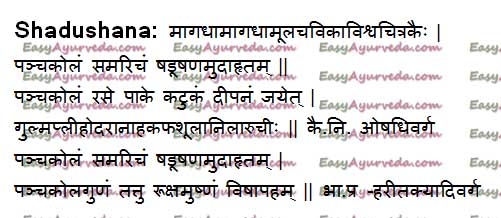The word ‘Shadushana’ refers to a group of six (Shad) herbs which have ushna (Ushana) Veerya (hot potency). Hence shadushana refers to six herbs i.e.
Pippali (Piper longum) – long pepper
Pippali moola (root of pippali), – long pepper root
Chavya (Piper retrofractum),
Chitraka (Plumbago zeylanica) – leadwort
Nagara ( Zingiber officinale) ginger and
Maricha (Piper nigrum).- black pepper
Table of Contents
ToggleShloka- Sanskrit verse

Acharya Bhavaprakasha mentioned Shadushana as Panchakola along with Maricha.
Quality of Shadushana
Rasa (Taste) – Katu (Pungent)
Guna (Qualities) Laghu (Light for digestion), Ruksha (Dry), Teekshna (Strong)
Vipaka – Katu (Undergoes Pungent taste after digestion)
Veerya (Potency) – Ushna (Hot)
Karma (Actions) – Kaphavata shamaka (reduces vitiated kapha and vata dosha)
Part used- Fruit (Pippali, Maricha and Chavya), Rhizome/ Root (Shunti, Chitraka and Pippali moola)
Dosage and anupana
Dose: About 2-3 g in divided dose/day
With western medicines
Seek your doctor’s advice if you are taking this product along with other western (allopathic/modern) medicines. Some Ayurvedic herbs can interact with modern medicine.
If both Ayurvedic and allopathic medicines are advised together, then it is best to take allopathic medicine first, wait for 30 minutes and then, after a gap of 15 – 30 minutes, take Ayurvedic medicine or as directed by the physician.
Can this be used while taking Homeopathic medicine?
Yes. This product does not react with homeopathic medicine.
With supplements like multivitamin tablets, Omega 3 fatty acids etc?
Yes. Generally, this product goes well with most of the dietary supplements. However, if you are taking more than one product per day, please consult your doctor for an opinion.
Anupana: Usually honey or sharkara is the anupana during the intake of Shadushana choorna. Honey and Sharkara will reduce the hot potency of the powder, prevent adverse action and aid in the proper therapeutic action of the herbal powder.
Side effects
Shelf life of shadushana powder:
The powder of shadushana can be preserved for a period of up to 1 year if it is stored in an air tight container. However if the seal of container is opened after use, then the preparation may lose its potency within 2 months. Also the potency may be lost if the formulation is exposed to moisture, sunlight and extreme temperature.
Method of preparation
Preparation of Shadushana powder:
All the 6 herbs mentioned above are taken individually and powdered in a pulverizer to fine powder form and later mixed in equal proportion to obtain the product called as Shadushana choorna.
Chemical constituents
The combination of six herbs contains mailnly piperine, piplartine, piplsterol, plumbagin and starch. Apart from these contents it also contains diaryl heptenones, diterpenes and gingesulphonic acid.
Action
Main action of Shadushana:
Gulmagna- Acts against the disease ‘gulma’
Anaha- Cures distention of abdomen
Pleehagna- Acts against inflammation of spleen
Shoolagna- Pain reliever
Udara- Acts against enlargement of abdomen
Aruchi- Loss of taste in the mouth, anorexia
Benefits
Uses of Shadushana:
- Powder of shadushana is given in a dose of 3 g with a glass of buttermilk or hot water to treat indigestion and anorexia.
- The paste of shadushana is mixed with hot water to prepare the paste and applied over joints having pain and inflammation.
- Patients suffering from diarrhea can be given the powder of shadushana in a dose of 2-4 g with buttermilk.
- To treat cough with phlegm and in conditions of rhinitis, 2- 4 g of shadushana powder can be given with honey.
- To fasten the ripening of ulcer filled with pus, shadushana powder mixed with butter can be applied over the pustule (external application) twice a day.
Contraindication: People suffering from peptic ulcer, gastritis, reflux disorders are advised not to take this powder as it may further aggravate the condition.
Research
Research articles related to Shadushana:
Anti- microbial activity: In this study an attempt is made to study about the anti- microbial activity of Piper species. Compared to streptomycin, all the extracts exhibited a good anti-bacterial activity.
Anti- helicobacter action: It has been shown that the presence of infection by Helicobacter pylori is strongly associated with gastric cancer and peptic ulceration. In this study, therefore, we have focused on establishing the anti-H. pylori activities of P. zeylanica L. The ethyl acetate extract exhibited the lowest minimum inhibitory concentrations against five H. pylori strains.
CNS stimulatory action: The effects of a 50% ethanol extract of the root of Plumbago zeylanica (P. zeylanica) were investigated on locomotor behaviour and central dopaminergic activity in rats. The ambulatory and rotatory behaviour in the treated groups were higher than in the control group (p < 0.05). There were marked differences in the ambulatory behaviour between 100 and 300 mg/kg, indicating that the responses were stimulatory and dose‐dependent.
Anti- oxidant activity: The main objective of this study was to investigate the antioxidant and antimicrobial activities of the crude extract of Plumbago zeylanica root. The extracts showed significant activities in all antioxidant assays in a concentration dependent manner. Crude extract was found to possess higher ferric reducing activity (ascorbic acid equivalents 227.011±0.042 mg AA/100 g) and DPPH activity of 156.00±0.048 mg AAE/100 g.
Action on platelet aggregation: Using the PRISMA guidelines, we systematically reviewed the results of clinical and observational trials regarding the effect of ginger on platelet aggregation in adults compared to either placebo or baseline data. Studies included in this review stipulated the independent variable was a ginger preparation or isolated ginger compound, and used measures of platelet aggregation as the primary outcome. The evidence that ginger affects platelet aggregation and coagulation is equivocal and further study is needed to definitively address this question.
Author:
Dr.BK.Prashanth M.D (Ayu), Ph.D
E mail: [email protected]
Click to consult Dr Prashanth BK
Can this be used during periods?
This product contains many hot ingredients such as leadwort, long pepper fruit and root etc. Due to hotness, it can worsen bleeding. If you experience increased periods, then consider reducing the dose of this medicine during periods.
Please consult your doctor before taking this medicine.
This article is written by Dr. Janardhana V Hebbar BAMS, MD (Ayu), PGDPSM, Managing Director, Easy Ayurveda Hospital.
It is reviewed by Dr. Raviganesh Mogra BAMS, MD (Ayu), Chief Medical Officer, Easy Ayurveda Hospital








